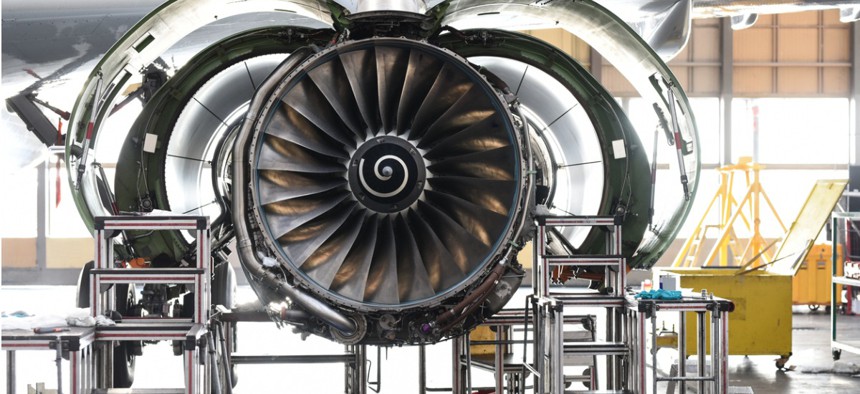Army Researchers Turn to DOD Supercomputers to Digitally Twin Gas Turbine Engine

Aircraft Jet engine maintenance in airplane hangar baranozdemir/istockphoto
It could lead to “disruptive new engine designs,” an engineer involved said.
Military researchers are set to use high performance supercomputing to develop the first physics-based virtual twin of an integrated gas turbine engine in a Defense Department-supported effort aligned with motor innovation.
“A demonstrated digital twin capability of a gas turbine engine will lead to a new design paradigm within the propulsion community,” Dr. Luis Bravo Robles told Nextgov on Thursday. “It will enable access to a full 360-degree aerothermal internal flow field enclosing a fully integrated compressor, combustor and turbine towards high-fidelity simulation of a full-engine.”
Bravo Robles is a research aerospace engineer at the Army Research Laboratory. He added that the pursuit has “the potential to lead to disruptive new engine designs for future Army propulsion platforms with increased performance, efficiency, and reliability at a much lower development cost and shorter timeline.”
Operating within the lab’s Weapons and Materials Research Directorate, Bravo Robles is a member of ARL’s team that submitted a winning proposal to tap next-level computing capabilities to advance this engine-pushing research.
For more than five years now, the Defense Department has awarded Frontier Projects, which allow for research, development and assessment outcomes that likely can’t be reached using assets that are typically available via its High Performance Computing Modernization Program. Bravo Robles, along with other ARL researchers, officials from the Naval Air Warfare Center and collaborators from Pratt & Whitney, the University of Cincinnati and Cascade Tech were recently selected to use DOD’s sophisticated supercomputing resources to explore large-scale integrated simulations of gas turbine engines and advance digital twin models in propulsion. This submission—Large-scale Integrated Simulations of Transient Aerothermodynamics in Gas Turbine Engines—“was the only Frontier Project selected from the Army” for fiscal 2022, Bravo Robles noted. It was one of four awards DOD made in its Foundational Research and Engineering category.
The others aim to use the Pentagon’s next-level supercomputing capabilities in laser- and hypersonic-related research, and more.
This type of digital twin being explored via Bravo Robles’ engine-centered project, he said, “is an analytical model constructed from first principles that solves the governing partial differential equations underpinning system performance.” To the engineer, “the challenge here is constructing an integrated predictive aerothermal model that couples the physics across components and provides full-scale engine analysis tools for robust design, operation, and maintenance.”
The simulations he and the team proposed to conduct will “use billions of grid points across the engine components requiring 10,000s of supercomputing cores presenting big-data challenges for parametric design and analysis,” Bravo Robles further explained. Integrating the full engine geometry requires complex computing capabilities, he said, and “access to thousands of runs using machine learning and uncertainty quantification to understand the complete design space.”
Resources will be allocated by DOD for this work beginning Oct. 1. The research is planned to span up to four years, and quarterly reviews will also be conducted on the project.






